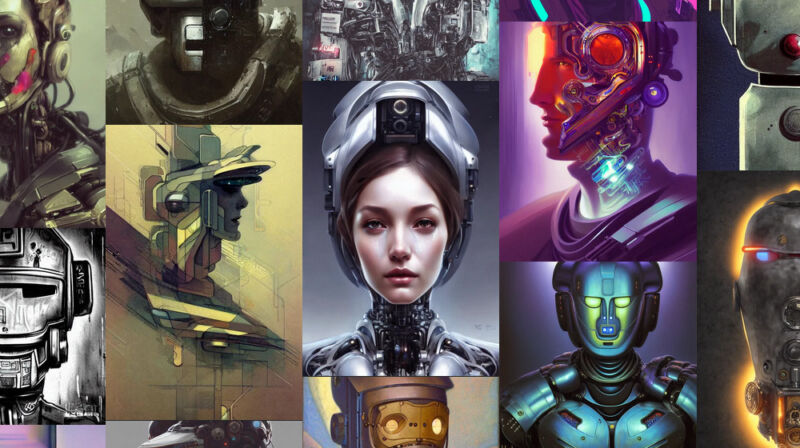Tales of numerous present —
Smaller paintings communities are banning painting synthesis amid a unparalleled wider paintings ethics debate.
Benj Edwards –

Extend / An assortment of robotic portraits generated by Get Diffusion as discovered on the Lexica search engine.
Confronted with an amazing amount of man made-intelligence-generated paintings flooding in, some on-line paintings communities bear taken dramatic steps to ban or curb its presence on their internet websites, together with Newgrounds, Inkblot Art work, and Fur Affinity, in accordance with Andy Baio of Waxy.org.
Baio, who has been following AI paintings ethics fastidiously on his weblog, first seen the bans and reported about them on Friday. To this degree, indispensable paintings communities DeviantArt and ArtStation bear now not made any AI-linked protection changes, nevertheless some vocal artists on social media bear complained about how unparalleled AI paintings they on a typical foundation to seek out on these platforms as properly.
The arrival of extensively accessible painting synthesis objects equal to Midjourney and Get Diffusion has provoked an intense on-line battle between artists who to seek out AI-assisted paintings as a produce of theft (further on that beneath) and artists who enthusiastically embody the quiet artistic devices.
Established artist communities are at a now not straightforward crossroads as a result of they dismay non-AI paintings getting drowned out by an numerous present of AI-generated paintings, and however the devices bear furthermore grow to be severely celebrated amongst a few of their members.
In banning paintings created through painting synthesis in its Art work Portal, Newgrounds wrote, “We need to protect the extent of curiosity on paintings made by people and now not bear the Art work Portal flooded with laptop-generated paintings.”
Fur Affinity cited considerations regarding the ethics of how painting synthesis objects be taught from current paintings, writing, “Our purpose is to bolster artists and their converse. We don’t ponder it’s in our neighborhood’s best pursuits to permit AI generated converse on the positioning.”
These are completely the favored strikes in a quickly evolving debate about how paintings communities (and paintings specialists) can adapt to contrivance that may probably invent limitless works of aesthetic paintings at a charge that no human working with out the devices may perhaps match.
Piece of a unparalleled wider paintings ethics debate

Extend / An array of non-AI artworks frail to converse Get Diffusion, assembled by Waxy.org.
The current wave of painting synthesis devices permits customers to form in a written description (referred to as a “instructed”) and output an similar painting, almost like magic. The outcomes in general need cherry-choosing and dedication to to seek out correct moral, nevertheless with a skillfully crafted instructed, the outcomes can imitate the works of human artists with most often lovely ingredient.
Essentially the most a hit prompts in general reference current artists and paintings internet websites by title nevertheless now not repeatedly alone. Mixing artists can to seek out fashionable quiet stylistic blends. As an illustration, proper right here is the instructed that created the robotic girl inside the guts of the picture on the pinnacle of this text in Get Diffusion:
Good-looking crying! feminine mechanical android!, half of portrait, intricate detailed ambiance, photorealistic!, intricate, orderly, extraordinarily detailed, digital portray, artstation, notion paintings, refined, racy focal degree, illustration, paintings by artgerm and greg rutkowski and alphonse mucha (Seed 79409656)
Essentially the most well-most celebrated painting synthesis objects converse the latent diffusion methodology to to seek out modern paintings by analyzing 1000’s and 1000’s of images with out consent from artists or copyright holders. Throughout the case of Get Diffusion, these images come sourced straight from the Cyber net, courtesy of the LAION-5B database. (Pictures discovered on the Cyber net in general comprise descriptions linked, which is excellent for teaching AI objects.)
Goal now not too way back, Baio and AI researcher Simon Willison grabbed data for higher than 12 million images in LAION-5B and created a search device that lets customers look correct right into a cramped nevertheless consultant lower of the unparalleled higher location. (It’s attainable you may perhaps presumably additionally furthermore search the LAION5B painting location for paintings—and even your grasp title—in a demo hosted on Github.)

Extend / A stare Jeremy Lipking, a residing ravishing paintings painter, brings up ends inside the LAION data location.
Ars Technica
A few weeks in the past, some artists began discovering their paintings inside the Get Diffusion data location, and as nicely they weren’t glad about it. Charlie Warzel wrote an in depth painting about these reactions for The Atlantic last week. With battle traces being drawn firmly inside the sand and quiet AI creativity devices coming out progressively, this debate will seemingly proceed for a while to come back all over again.

